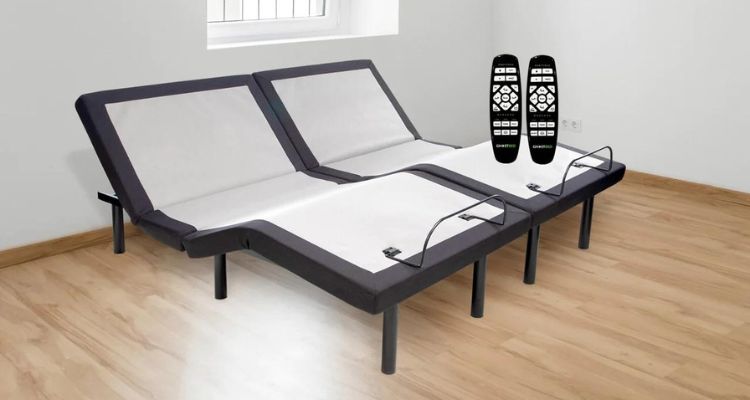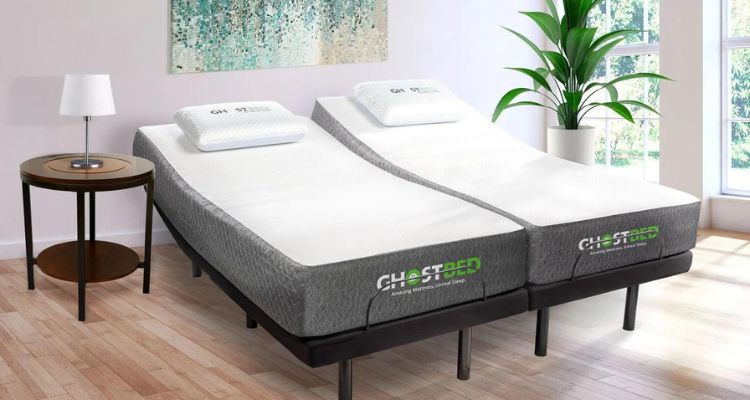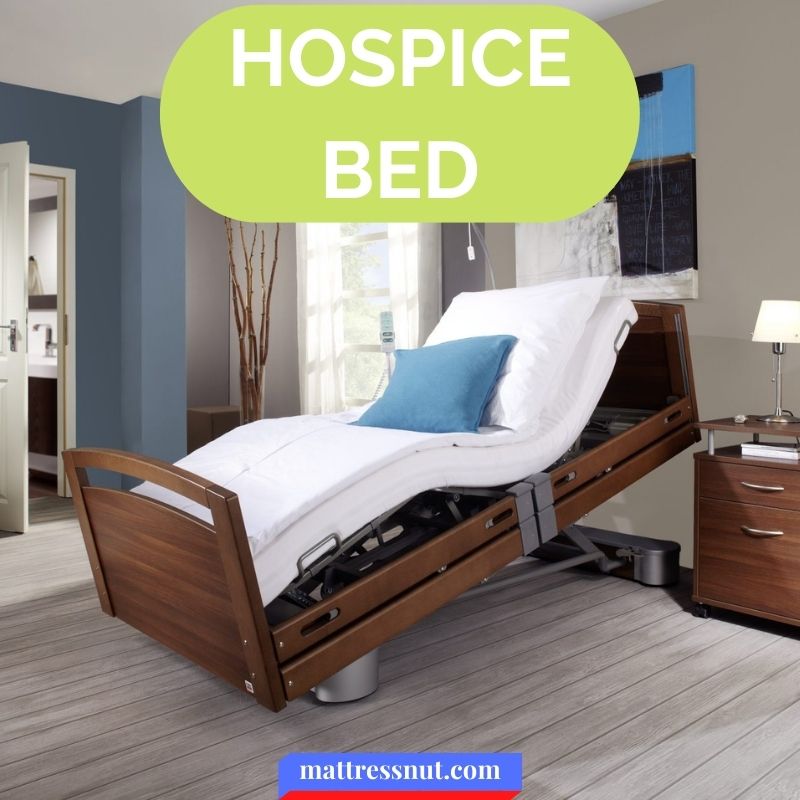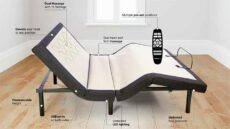Hospice care is a way to let a patient live out their lives in peace. Finding the right hospice bed is instrumental to a good life. You want to ensure that you or your loved ones do not feel discomfort. We picked the best hospice beds with adequate comfort and features. Take a look.
The Best Bed for Hospice and Palliative Care
A comfortable hospice bed with independent head and feet elevation.
The GhostBed Adjustable Base is one of the best hospice services bed bases. With this base, you can independently adjust the head and feet elevation. In addition, the bed base can provide comfort and support to a patient with serious illness.
The bed features multiple preset positions for lounging, watching TV, laying flat, and it even has a zero-gravity mode. Moreover, this hospice bed provides a two-zone independent head and foot massage. The massager includes 3 modes with 3 different intensities. But won’t it make any sound? Not at all. The massaging action is whisper-quiet and will not become a pain in the ears.
And that’s not all. The GhostBed comes with under-bed LED lighting. So you can have a soft, warm night light that will ensure you can always find your flip-flops. It also serves an aesthetic purpose.
All of these features can be conveniently controlled via the provided remote control. The remote control also has an in-built flashlight for emergency purposes.
But wait, there’s more. The GhostBed features 4 USB ports for different amperages to charge up devices and medical equipment. And the ports face downwards, so the cords always stay out of the way.
The best part is that this bed base does not require special mattresses or frames. It conveniently works with any existing latex, memory, or hybrid mattresses. You can either use it separately or attach it to an existing bed frame. The frame must have a clear opening in the middle and the slats, if any, removed.
Sometimes beds can be hard to get in and out of. The GhostBed Adjustable Base has 3 heights: 15”, 11”, and 7”. These can adjust simply by screwing and unscrewing their legs.
If you sleep hot in the summer, you can pair your adjustable base with the GhostBed Luxe (check 10 great mattresses for adjustable bed). It’s a memory foam mattress with gel-infused technology that keeps you cool at night.
What Is a Hospice Bed?
A hospice bed is a unique bed for patients under hospice care. These beds differ from regular beds because they provide more security, comfort, and adjustability. Additionally, hospice beds give elevation to the head and the feet. This pairs well with certain forms of therapy and gives the patient extra comfort. In some beds, the bed raising and lower mechanism may be either semi-electric or fully electric. This lends some level of independence to the patient when adjusting the elevation of their bed.
Modern hospice beds include compatibility with multiple medical equipments. These are the equipment necessary to monitor and maintain the patient’s health. They come with outlets and USB ports so patients can safely use these devices.
What Do Hospice Hospital Beds Look Like?
Hospice hospital beds may look different depending on the brand you buy from. But in most cases, a hospice bed looks like a regular hospital bed. These beds are traditionally double beds that the attendant can raise and lower with an adjustable head and foot. Modern hospice beds may also feature rails at the side of the end to prevent the patient from rolling over or leaving the bed unsupervised.
Hospice beds used in hospitals have a metal frame that can be wheeled around. These beds are often painted white with white bed sheets. Hospice beds at homes and retirement centers may be slightly homely. They may use wooden frames, or the paint job may mimic wood. And the bedsheets can be kept in any color.

What Are The 4 Levels of Care for Hospice?
Every hospice care provider that is Medicare-certified must be able to offer the following 4 levels of hospice care:
Hospice Care at Home:
Some patients may choose to get hospice care at home. In these instances, the Medicare healthcare worker must provide routine home visits. This is to safeguard the comfort and dignity of the patient. Medical supplies and equipment specific to the diagnoses will be provided by Medicare for free. Likewise, any appropriate medication will also be covered by Medicare.
Continuous Hospice Care:
A Medicare-certified hospice care provider must be able to provide hospice care 24/7, whenever necessary. This is to monitor and manage the patient’s symptoms. This also helps the patient avoid being hospitalized until routine care services can continue.
Inpatient Hospice Care:
If the symptoms cannot be managed from home, the provider should be able to provide inpatient care. The patient will be taken to a hospice care facility and provided with the relevant medical procedures. This is only when it is necessary to continue providing quality hospice care.
Respite Care:
Respite care is when a patient spends some time in an institution to give their primary caregivers a break. This is done to let the caregiver get some time off and to avoid burnout. It helps them perform even more efficiently in the long run. Respite care takes place in a Medicare-certified hospice care institution. And it is usually for only a day to up to several weeks.
What Is the Size of a Hospice Bed?
Hospice beds come in different sizes as well as with different weights. The standard size for a hospice bed is 80 inches in length by 36 inches in width. As you may have noticed, this doesn’t match traditional sizes like King, Queen, or Twin. However, it is the closest to a Twin XL size bed.
Other sizes also exist, mainly to accommodate bigger individuals or to fulfill. Certain needs. For standard hospice beds, you’ll need a Twin XL sheet to cover the bed.

What Hospice Does Not Tell You?
There are some common misconceptions about what hospice can and cannot do. Here is the reality behind hospice care:
- Hospice care is not expensive. In reality, it often doesn’t cost a penny, and all of it is covered by Medicare or other insurance.
- Hospice is not a place. It is up to the patient to decide where they want to receive hospice care. This can be at home with their family or nursing facility.
- Hospice can be discontinued at any time. The patient can abandon hospice care for curative treatment and even return to hospice care. The patient is in complete control all the time.
- Contrary to popular belief, hospice doesn’t stop after 6 months. So yes, it is recommended for patients with less than 6 months of life expectancy. But some patients can be in hospice for a very long time. If you meet the Medicare criteria, you can even stay eligible for hospice forever.
- Hospice doesn’t mean you have given up all hope. It is simply a way for patients and their families to stop exhaustive and expensive curative treatment and opt for a more peaceful way of life.
- Hospice does not accelerate death or help patients die. Sometimes patients may even live longer than expected under hospice care. Hospice care manages symptoms and makes the patient as comfortable as possible.
How Do I Prepare My Home for Hospice?
First off, decide where you want to place the bed. Remember that changing the location once all the equipment has been set up will be hard. So choose a spot you like, with lots of soft lighting and ventilation. Many patients choose to replace their existing bed with their hospice bed. Make sure the location has enough space to accommodate a bed, medical equipment, and other devices.
Next, get to preparing the bathroom. The bathroom is often where patients tend to fall and get hurt. Depending on the patient’s needs, you may need to integrate handicap facilities. For example, use non-slip mats, grab bars, shower chairs, and stools. Ensure that the bathroom is close to the hospice bed. Some patients may even need a bedside commode.
After that, you should start decluttering the room and making space for the patient. Hospice rooms require many equipment and outlets for connecting the devices.
Next, ensure that small item that can cause mobility issues are not there. Things like throw rugs, chairs, tables, and children’s toys should allow better mobility.
How Long Does the Average Hospice Patient Live?
So what is the average time that a patient spends on hospice care? A recent survey by Trella Health finds that the average is around 78 days. Patients who are eligible for hospice are the ones who expect to live only 6 more months or less. But what if a patient ends up living longer than 6 months? Then the patient must consult the doctor. If the doctor says the patient will likely not survive the next 6 months, they can resume hospice care.
Can You Be in Hospice for Years?
Yes, it is possible. Patients are there for extra care if their life expectancy is 6 months or less. Hospice can be resumed if a patient lives longer than that (and many do). The only catch is that the patient must be eligible by Medicare standards.
Hospice can continue if a doctor declares that the patient will likely not survive the next 6 months. Many people can be in hospice for years. And if their condition gets better, they may even advance to a different form of treatment. Remember that hospice care only keeps the patient comfortable but doesn’t treat the terminal ailment.
When Does Medicare Cover Adjustable Beds?
Medicare will cover any special medical equipment like adjustable beds used in your home if your doctor perceives them. The only condition is that you must have a disease or other condition that makes it necessary to get an adjustable bed. You will need to physically visit your doctor or healthcare provider within 6 months after the doctor has placed the bed order.
Go for the registration with Medicare Part B, which covers the adjustable bed (also check the best mattresses for an adjustable bed). You must have a condition that requires an adjustable bed along with a doctor’s prescription. Moreover, there must be medical records to support your claims. You also need physician reports that describe the condition you have.
Which Adjustable Beds Are Covered?
Medicare covers many adjustable beds. Medicare will cover all standard hospice beds. But if your healthcare provider or doctor recommends any other bed or accessories, they will provide for that too.
As an example, if your doctor recommends adjustable height, then Medicare will provide a bed that features that. Similarly, you can add other things like gel-like mattress pads can add if your doctor suggests.
Here’s a list of what specific medical items Medicare covers for adjustable beds:
- Synthetic and lambswool sheepskin pads.
- Air pressure pads for standard mattresses.
- Dry pressure pads for traditional mattresses.
- Fixed-height hospital beds with or without the side railings and mattress.
- Air fluidized beds.
- Gel or gel-like pressure mattress pads.
- Variable-height hospice beds with or without the mattress and side railings.
- Semi-electric hospital beds with adjustable head and foot with or without the mattress and side railings.
- Fully electric hospice beds with adjustable head, height, and foot, with or without the mattress or side rails.
- An extra-wide heavy-duty hospice bed with 350-600 pound capacity side railings with or without the mattress.
- Water-pressure pads for standard mattresses.
- A hospital-grade pediatric crib that is fully enclosed.
Since the GhostBed uses a hospital-grade adjustable base motor, you can save hundreds if you get a doctor’s note for it.
What are the main features of a good hospice bed?
Some key features to look for in a high-quality hospice bed include adjustable height, independent head and foot elevation, side railings, built-in massagers, USB charging ports, and compatibility with medical equipment. Having adjustable height makes it easier for the patient or caregiver to get in and out of bed. Independent head and foot adjustment allows the patient to find the most comfortable position.
Side railings provide safety and fall prevention. Massagers can help relieve pain and discomfort. USB ports allow medical devices to be charged right at the bedside. Overall, the best hospice beds maximize comfort, adjustability, and medical compatibility.
What mattress types work best with hospice beds?
The most common and recommended mattress types for hospice beds are memory foam, latex, and hybrid. Memory foam contours perfectly to the body to relieve pressure points. It also prevents motion transfer. Latex is naturally cooling and responsive. Hybrid combines pressure relief of foam with the bounce of coils.
The key is finding a high-quality mattress in the right firmness level for the patient’s needs that complements the adjustability of the base. Avoid innerspring mattresses as they lack pressure relief. Always check the mattress’s compatibility with the base before purchasing.
How can I make my home safer for hospice care?
Some tips for preparing your home for hospice care include installing grab bars and railings in the bathroom for support, putting night lights in hallways, removing area rugs and clutter that could cause falls, keeping medical supplies and medications organized and in easy reach, setting up the hospice bed near a power outlet, installing an emergency alert system, making sure walkways are wide and clear, placing a bedside commode in or near the bedroom if needed, and adapting the patient’s bathroom with a shower chair, elevated toilet seat, or other assistive equipment recommended by an occupational therapist. These small changes can really optimize home safety.
Our Recommendation:
Hospice care is comfort treatment and gives you the right equipment and care to live your life in peace. Getting the right hospice bed is crucial to ensuring that you or your loved one are always content. These were just some of the best hospice beds out there that provide extra comfort to the user (also check the most comfortable mattresses). So, pick the right one and give yourself or your loved one the life they deserve.


